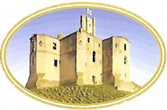Warkworth’s Early Rulers
The name Warkworth comes from the Saxon times when in 737 it was known as Wercworde, a property of Ceolwulph, the Saxon King of Northumbria. In 875 the village was burned to the ground by Halfden the Dane who sailed into the Coquet estuary and attacked from the East (now Helsay Farm) although there was no mention of a castle at this time it is likely there was some form of fortified structure.
Around 1156, the Manor at Warkworth was granted by Henry II to one of his trusted knights, Roger fitz Richard the custodian of Newcastle. Roger the son of (i.e. fitz) Richard was a member of the Clavering family and held the castle and barony of Warkworth as fee for his knightly service and dropped the Clavering surname.

In 1173, William the Lion of Scotland destroyed the ‘weak’ wooden castle during one of his raids into Northumberland; the following year, 1174, Duncan Earl of Fife with a large Scottish army also raided the town burning it to the ground and then massacred three hundred inhabitants in St. Lawrence’s Church where they sheltered.
Roger fitz Richard died in 1178 and was succeeded by his son Robert fitz Roger who rebuilt the castle in stone, some of which remains today in parts of the outer walls, the postern and barbican. King John visited the castle in1213 and granted to Warkworth the privilege of holding a weekly market in the New Town or Tenterheugh, which forms part of the current graveyard.
Robert fitz Roger ruled the barony for 39 years, dying in 1214; he passed on the barony to his son John fitz Robert who had the distinction of being one of the 24 ‘Rebel Barons’ to sign the Magna Carta.
At his death in 1240 his son Roger fitz John assumed the barony but only for nine years being killed in a tilting contest in Normandy. He was succeeded by his then infant son Robert fitz Roger 2nd who would have been the host to King Edward 1st when he stayed at Warkworth in 1292. At this time the castle must have been a substantial structure as a large amount of money for the English Treasury was moved from Berwick to the castle for safekeeping.
In 1310, Robert fitz Roger 2nd was succeeded by his son John fitz Robert who reverted to his original family name of John de Clavering. In 1327 the castle was again besieged by Scots but the castle has a substantial garrison of horse and foot which repelled the attack and caused significant losses to the retreating Scots. In the same year a second invasion led by Robert the Bruce was similarly dispatched. John fitz Robert / John de Clavering had no male heirs and for consideration of a lifetime estate handed the Barony back to the king; on his death in 1332 King Edward III granted the Barony of Warkworth to Sir Henry Percy in lieu of payment to protect the English realm from the Scottish invaders and so began the Percy family dynasty.

